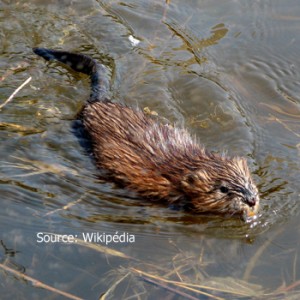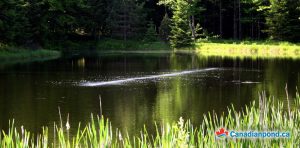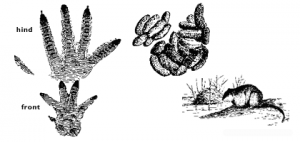What To Do About the Muskrat?
Muskrat is an Aquatic Rodent that Can be Problematic
The muskrat is one of those animals that it is really pleasant to observe and meet … as long as it stays with the neighbor! Indeed, although seemingly harmless, this little rodent could bring you a lot of torment, as it can be effective in disturbing the water in your pond or in digging its burrow in the banks, thus lowering the level of water. It likes to chew at the pipes of your aeration system, causing you a few headaches. In addition, a carrier of parasites that can infect humans, it is important to keep them away from domestic ponds.

In order to be able to fight against this seemingly harmless aquatic rodent, it is important to understand how it lives and how to recognize it.
The muskrat (Ondatra zibethicus) takes its name from its two musk glands which during the breeding season secrete a yellowish substance, leaving a musk smell behind it. This rodent, which generally measures around fifty centimeters for an average weight of 1 kg, has the particularity of being able to feed itself without opening its mouth, thanks to its incisors located in front of its lips. This characteristic allows it to feed under the winter ice, on its favorite dishes – cattails and rushes. It can dive for 15 minutes without rising to the surface to regain oxygen. It has thick, dense, short-haired, waterproof brown fur, a slender, flattened tail that can reach 10 inches in length, and barely hairy, non-webbed paws. Its hind legs are used mainly for swimming. The front ones allow it to hold its food and to dig burrows or make its huts.
The muskrat’s preferred habitat is swampy areas of lakes and slow-flowing streams in North America as well as Europe and northern Asia. The most frequented sites are those which present a large quantity of rushes, cattails and other aquatic plants which they are fond of. The survival of the muskrat depends on its ability to feed under the ice in winter, so it prefers to dig its burrow in the banks whose relatively steep slope allows easy access to sufficiently deep water to be below the ice level. Rather than digging burrows, the muskrat can also build a main lodge (house) and secondary huts (food stores) made from cattails, mud and dried plants. Thus, the distaff not only plays an important role in its diet, but also in the construction of its huts.
The muskrat breeding season begins with the thaw, and it is not uncommon in North America to witness three calvings per year, with 5 to 10 youngs per litter. Newborns become independent as early as their sixth week, but they face significant predation, which is why their lifespan usually does not exceed four years.
How to Tell if a Muskrat has Established Itself in Your Pond
To find out if muskrats have taken up residence in your pond, you can look for the following distinctive signs:
- unusually cloudy or brownish water,
- presence of pieces of cattail floating on the surface (especially in the spring because the muskrats feed on the cattail stems during the winter and the plants remains float to the surface after thaw),
- a drop in the water level of 30 cm or more, that had never happened in the past,
- small droppings on the rocks,
- traces of prints in the mud,
- you may simply see it swimming or foraging near the shores, but the shy nature of this animal can make it inconscpicuous.
By building burrows on the banks, they can prove very harmful or even dangerous for the stability of structures such as dikes and watersheds. In addition, muskrats carry parasites which, when drinking infected water, can cause disease in humans. The main ones are giardiasis which causes severe diarrhea, and cryptosporidia which can cause bloody diarrhea, serious blood infections and even death.
To get rid of a muskrat, you can either eliminate it with the help of a wildlife officer possessing a trapping license, or make the pond uninhabitable for the animal.
How to Make your Pond Uninhabitable for Muskrats
The muskrat inhabits stagnant bodies of water, of which it likes the specific characteristics. The goal will be to remove these characteristics as much as possible.
Start by reducing their food source: if possible, eliminate cattails, sedges and phragmites. Try using one of our aquatic tools to make the job easier. For a public water body, it is best to get approval before removing these aquatic plants. If the plants are present in a localized area, you can prune them and then install a benthic barrier such a Lake Bottom Blanket available in our online shop. A benthic barrier is an aquatic PVC fabric installed at the bottom of the water that allows gas exchange while blocking light, preventing the growth of unwanted plants. The application of an aquatic dye that blocks some of the light available for plant regrowth will support the effect of the aquatic barrier.

Also consider adding an aeration system to your pond. Muskrats prefer calm water with little water circulation. While being very beneficial to your water body in general, aeration will provide vertical water circulation that can be annoying for muskrats. This is why a linear diffuser such as Bubble Tubing® is very popular for irrigation bassins and ponds: aeration is distributed all along the pond, and not only in a localized area, as would be the case with a diffuser disc. Aeration also helps to reduce the amount of silt present at the bottom of the pond because good aeration provides the necessary oxygen to the bacterial community that carries out the organic decomposition of the muck. This muck is very nutritious for plants when not totally oxidized. It is therefore important to control the accumulation of mud and even to make regular bioaugmentation treatments with a beneficial and natural bacterial product.
Finally, muskrats prefer shallow bodies of water (four to six feet deep). If you’re thinking about digging a pond, keep this in mind. If your pond is already dug, aeration can help you keep the maximum depth possible by removing sludge from the bottom. CanadianPond.ca can advise you on aquatic habitat management. Contact us if you still have questions.
Trapping the muskrat
In Canada, it is illegal to kill fur animals by poisoning, so small pieces of carrots full of poison left in the path of rodents is not an option. In addition to the ban, this technique presents the risk that another animal may be the victim of the treatment.
It is then necessary to use traps to capture the animal, alive or dead. The problem with eliminating the animal is that there is a high probability that another one will come to take its place if you do not also act on the habitat. For example, to make the pond unsuitable for rodent pests, you can remove aquatic vegetation (especially cattails), or put up a screen along the shoreline to make it more difficult to tunnel. The screen should be applied 12 in cm above the water level to 90 cm below. Another technique is to keep the grass cut less than 10 cm from the edge, but this is not consistent with maintaining a buffer zone for better water quality.
Finally, the easiest thing to do is to contact your local wildlife officer to find out your options, regulations and permits required to get rid of these guests. Muskrats are considered a nuisance species, and it is permitted to eliminate them on your property. The best time to trap them is in the spring.
Related Articles:

